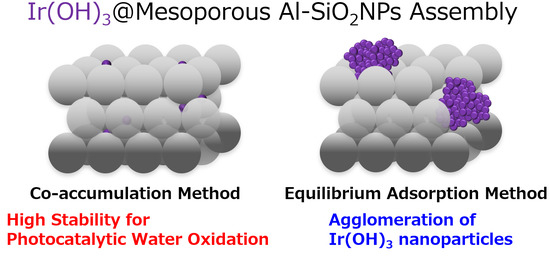Immobilization of Ir(OH)3 Nanoparticles in Mesospaces of Al-SiO2 Nanoparticles Assembly to Enhance Stability for Photocatalytic Water Oxidation
Abstract
1. Introduction
2. Results and Discussion
2.1. Preparation and Water Oxidation Catalysis of Ir(OH)3 Nanoparticles with and without SiO2NPA
2.2. Size Effect of SiO2 Nanoparticles in Ir(OH)3/SiO2NPA-CAs on Catalytic Stability for Water Oxidation Catalysis
2.3. Suppression of Leaching of Ir(OH)3 Nanoparticles from SiO2NPA by Surface Modification with Al3+
3. Materials and Methods
3.1. Materials and Chemicals
3.2. Synthesis
3.3. Characterization
3.4. Photocatalytic Water Oxidation
4. Conclusions
Supplementary Materials
Author Contributions
Funding
Acknowledgments
Conflicts of Interest
References
- Wang, Z.; Li, C.; Domen, K. Recent Developments in Heterogeneous Photocatalysts for Solar-Driven Overall Water Splitting. Chem. Soc. Rev. 2019, 48, 2109–2125. [Google Scholar] [CrossRef] [PubMed]
- Kudo, A.; Yoshino, S.; Tsuchiya, T.; Udagawa, Y.; Takahashi, Y.; Yamaguchi, M.; Ogasawara, I.; Matsumoto, H.; Iwase, A. Z-Scheme Photocatalyst Systems Employing Rh- and Ir-Doped Metal Oxide Materials for Water Splitting Under Visible Light Irradiation. Faraday Discuss. 2019, 215, 313–328. [Google Scholar] [CrossRef] [PubMed]
- Dogutan, D.K.; Nocera, D.G. Artificial Photosynthesis at Efficiencies Greatly Exceeding That of Natural Photosynthesis. Acc. Chem. Res. 2019, 52, 3143–3148. [Google Scholar] [CrossRef] [PubMed]
- Nocera, D.G. Solar Fuels and Solar Chemicals Industry. Acc. Chem. Res. 2017, 50, 616–619. [Google Scholar] [CrossRef]
- Harriman, A. Prospects for Conversion of Solar Energy into Chemical Fuels: The Concept of a Solar Fuels Industry. Philos. Trans. Roy. Soc. A 2013, 371, 20110415. [Google Scholar] [CrossRef]
- Artero, V.; Fontecave, M. Solar Fuels Generation and Molecular Systems: Is It Homogeneous or Heterogeneous Catalysis? Chem. Soc. Rev. 2013, 42, 2338–2356. [Google Scholar] [CrossRef]
- Abe, R. Recent Progress on Photocatalytic and Photoelectrochemical Water Splitting Under Visible Light Irradiation. J. Photochem. Photobiol. C 2010, 11, 179–209. [Google Scholar] [CrossRef]
- Ye, S.; Ding, C.M.; Liu, M.Y.; Wang, A.Q.; Huang, Q.G.; Li, C. Water Oxidation Catalysts for Artificial Photosynthesis. Adv. Mater. 2019, 31, 1902069. [Google Scholar] [CrossRef]
- Schneider, J.; Bangle, R.E.; Swords, W.B.; Troian-Gautier, L.; Meyer, G.J. Determination of Proton-Coupled Electron Transfer Reorganization Energies with Application to Water Oxidation Catalysts. J. Am. Chem. Soc. 2019, 141, 9758–9763. [Google Scholar] [CrossRef]
- Matheu, R.; Ertem, M.Z.; Gimbert-Suriñach, C.; Sala, X.; Llobet, A.A. Seven Coordinated Molecular Ruthenium-Water Oxidation Catalysts: A Coordination Chemistry Journey. Chem. Rev. 2019, 119, 3453–3471. [Google Scholar] [CrossRef]
- Li, W.L.; Li, F.S.; Yang, H.; Wu, X.J.; Zhang, P.L.; Shan, Y.; Sun, L.C. A Bio-Inspired Coordination Polymer as Outstanding Water Oxidation Catalyst via Second Coordination Sphere Engineering. Nat. Commun. 2019, 10, 5074. [Google Scholar] [CrossRef] [PubMed]
- Francàs, L.; Corby, S.; Selim, S.; Lee, D.H.; Mesa, C.A.; Godin, R.; Pastor, E.; Stephens, I.E.L.; Choi, K.S.; Durrant, J.R. Spectroelectrochemical Study of Water Oxidation on Nickel and Iron Oxyhydroxide Electrocatalysts. Nat. Commun. 2019, 10, 5208. [Google Scholar] [CrossRef] [PubMed]
- Meyer, T.J.; Sheridan, M.V.; Sherman, B.D. Mechanisms of Molecular Water Oxidation in Solution and on Oxide Surfaces. Chem. Soc. Rev. 2017, 46, 6148–6169. [Google Scholar] [CrossRef] [PubMed]
- Fukuzumi, S.; Kojima, T.; Lee, Y.M.; Nam, W.W. High-Valent Metal-Oxo Complexes Generated in Catalytic Oxidation Reactions Using Water as an Oxygen Source. Coord. Chem. Rev. 2017, 333, 44–56. [Google Scholar] [CrossRef]
- Okamura, M.; Kondo, M.; Kuga, R.; Kurashige, Y.; Yanai, T.; Hayami, S.; Praneeth, V.K.K.; Yoshida, M.; Yoneda, K.; Kawata, S.; et al. A Pentanuclear Iron Catalyst Designed for Water Oxidation. Nature 2016, 530, 465–468. [Google Scholar] [CrossRef]
- Diaz-Morales, O.; Raaijman, S.; Kortlever, R.; Kooyman, P.J.; Wezendonk, T.; Gascon, J.; Fu, W.T.; Koper, M.T.M. Iridium-Based Double Perovskites for Efficient Water Oxidation in Acid Media. Nat. Commun. 2016, 7, 12363. [Google Scholar] [CrossRef]
- Galán-Mascarós, J.R. Water Oxidation at Electrodes Modified with Earth-Abundant Transition-Metal Catalysts. ChemElectroChem 2015, 2, 37–50. [Google Scholar] [CrossRef]
- Kärkäs, M.D.; Verho, O.; Johnston, E.V.; Åkermark, B. Artificial Photosynthesis: Molecular Systems for Catalytic Water Oxidation. Chem. Rev. 2014, 114, 11863–12001. [Google Scholar] [CrossRef]
- Matienzo, D.D.J.; Settipani, D.; Instuli, E.; Kallio, T. Active IrO2 and NiO Thin Films Prepared by Atomic Layer Deposition for Oxygen Evolution Reaction. Catalysts 2020, 10, 92. [Google Scholar] [CrossRef]
- Volpe, A.; Tubaro, C.; Natali, M.; Sartorel, A.; Brudvig, G.W.; Bonchio, M. Light-Driven Water Oxidation with the Ir-Blue Catalyst and the Ru(bpy)32+/S2O82− Cycle: Photogeneration of Active Dimers, Electron-Transfer Kinetics, and Light Synchronization for Oxygen Evolution with High Quantum Efficiency. Inorg. Chem. 2019, 58, 16537–16545. [Google Scholar] [CrossRef]
- Tomihara, R.; Koyasu, K.; Nagata, T.; Wu, J.W.J.; Nakano, M.; Ohshimo, K.; Misaizu, F.; Tsukuda, T. Structural Evolution of Iridium Oxide Cluster Anions IrnOm− (n = 5−8) with Sequential Oxidation: Binding Mode of O Atoms and Ir Framework. J. Phys. Chem. C 2019, 123, 15301–15306. [Google Scholar] [CrossRef]
- Ohno, H.; Nohara, S.; Kakinuma, K.; Uchida, M.; Uchida, H. Effect of Electronic Conductivities of Iridium Oxide/Doped SnO2 Oxygen-Evolving Catalysts on the Polarization Properties in Proton Exchange Membrane Water Electrolysis. Catalysts 2019, 9, 74. [Google Scholar] [CrossRef]
- Massué, C.; Pfeifer, V.; Huang, X.; Noack, L.; Tarasov, A.; Cap, S.; Schlögl, R. High-Performance Supported Iridium Oxohydroxide Water Oxidation Electrocatalysts. Chem. Sus. Chem. 2017, 10, 1943–1957. [Google Scholar] [CrossRef] [PubMed]
- Guan, J.Q.; Li, D.; Si, R.; Miao, S.; Zhang, F.X.; Li, C. Synthesis and Demonstration of Subnanometric iridium Oxide as Highly Efficient and Robust Water Oxidation Catalyst. ACS Catal. 2017, 7, 5983–5986. [Google Scholar] [CrossRef]
- Chandra, D.; Takama, D.; Masaki, T.; Sato, T.; Abe, N.; Togashi, T.; Kurihara, M.; Saito, K.; Yui, T.; Yagi, M. Highly Efficient Electrocatalysis and Mechanistic Investigation of Intermediate IrOx (OH)y Nanoparticle Films for Water Oxidation. ACS Catal. 2016, 6, 3946–3954. [Google Scholar] [CrossRef]
- Hidalgo-Acosta, J.C.; Méndez, M.A.; Scanlon, M.D.; Vrubel, H.; Amstutz, V.; Adamiak, W.; Opallo, M.; Girault, H.H. Catalysis of Water Oxidation in Acetonitrile by Iridium Oxide Nanoparticles. Chem. Sci. 2015, 6, 1761–1769. [Google Scholar] [CrossRef]
- Hong, D.C.; Murakami, M.; Yamada, Y.; Fukuzumi, S. Efficient Water Oxidation by Cerium Ammonium Nitrate with [IrIII(cp*)(4,4’-bishydroxy-2,2’-bipyridine)(H2O)]2+ as a Precatalyst. Energ. Environ. Sci. 2012, 5, 5708–5716. [Google Scholar] [CrossRef]
- Hintermair, U.; Hashmi, S.M.; Elimelech, M.; Crabtree, R.H. Particle Formation during Oxidation Catalysis with Cp* Iridium Complexes. J. Am. Chem. Soc. 2012, 134, 9785–9795. [Google Scholar] [CrossRef]
- Macchioni, A. The Middle-Earth between Homogeneous and Heterogeneous Catalysis in Water Oxidation with Iridium. Eur. J. Inorg. Chem. 2019, 2019, 7–17. [Google Scholar] [CrossRef]
- Shilpa, N.; Manna, J.; Rajput, P.; Rana, R.K. Water Oxidation Catalyst via Heterogenization of Iridium Oxides on Silica: A Polyamine-Mediated Route to Achieve Activity and Stability. ACS Catal. 2016, 6, 5699–5705. [Google Scholar] [CrossRef]
- Takeda, H.; Ohashi, K.; Goto, Y.; Ohsuna, T.; Tani, T.; Inagaki, S. Light-Harvesting Photocatalysis for Water Oxidation Using Mesoporous Organosilica. Chem. Eur. J. 2014, 20, 9130–9136. [Google Scholar] [CrossRef] [PubMed]
- Junge, H.; Marquet, N.; Kammer, A.; Denurra, S.; Bauer, M.; Wohlrab, S.; Gärtner, F.; Pohl, M.M.; Spannenberg, A.; Gladiali, S.; et al. Water Oxidation with Molecularly Defined Iridium Complexes: Insights into Homogeneous versus Heterogeneous Catalysis. Chem. Eur. J. 2012, 18, 12749–12758. [Google Scholar] [CrossRef] [PubMed]
- Liu, X.; Maegawa, Y.; Goto, Y.; Hara, K.; Inagaki, S. Heterogeneous Catalysis for Water Oxidation by an Iridium Complex Immobilized on Bipyridine-Periodic Mesoporous Organosilica. Angew. Chem. Int. Ed. 2016, 55, 7943–7947. [Google Scholar] [CrossRef] [PubMed]
- Han, H.X.; Frei, H. In Situ Spectroscopy of Water Oxidation at Ir Oxide Nanocluster Driven by Visible TiOCr Charge-transfer Chromophore in Mesoporous Silica. J. Phys. Chem. C 2008, 112, 16156–16159. [Google Scholar] [CrossRef]
- Nakamura, R.; Frei, H. Visible Light-Driven Water Oxidation by Ir Oxide Clusters Coupled to Single Cr Centers in Mesoporous Silica. J. Am. Chem. Soc. 2006, 128, 10668–10669. [Google Scholar] [CrossRef]
- Canning, J.; Ma, M.; Gibson, B.C.; Shi, J.; Cook, K.; Crossley, M.J. Highly Ordered Mesoporous Silica Microfibres Produced by Evaporative Self-Assembly and Fracturing. Opt. Mater. Express 2013, 3, 2028–2036. [Google Scholar] [CrossRef]
- Canning, J.; Huyang, G.; Ma, M.; Beavis, A.; Bishop, D.; Cook, K.; McDonagh, A.; Shi, D.Q.; Peng, G.D.; Crossley, M.J. Percolation Diffusion into Self-Assembled Mesoporous Silica Microfibres. Nanomaterials 2014, 4, 157–174. [Google Scholar] [CrossRef]
- Naqshbandi, M.; Canning, J.; Gibson, B.C.; Nash, M.M.; Crossley, M.J. Room Temperature Self-Assembly of Mixed Nanoparticles into Photonic Structures. Nat. Commun. 2012, 3, 1188. [Google Scholar] [CrossRef]
- Nara, T.Y.; Togashi, H.; Ono, S.; Egami, M.; Sekikawa, C.; Suzuki, Y.; Masuda, I.; Ogawa, J.; Horinouchi, N.; Shimizu, S.; et al. Improvement of Aldehyde Tolerance and Sequential Aldol Condensation Activity of Deoxyriboaldolase via Immobilization on Interparticle Pore Type Mesoporous Silica. J. Mol. Catal. B 2011, 68, 181–186. [Google Scholar] [CrossRef]
- Yamada, Y.; Tadokoro, H.; Naqshbandi, M.; Canning, J.; Crossley, M.J.; Suenobu, T.; Fukuzumi, S. Nanofabrication of a Solid-State, Mesoporous Nanoparticle Composite for Efficient Photocatalytic Hydrogen Generation. Chem. Plus. Chem. 2016, 81, 521–525. [Google Scholar] [CrossRef]
- Chen, S. Preparation of Monosize Silica Spheres and Their Crystalline Stack. Colloids Surf. A 1998, 142, 59–63. [Google Scholar] [CrossRef]
- Zhao, Y.X.; Hernandez-Pagan, E.A.; Vargas-Barbosa, N.M.; Dysart, J.L.; Mallouk, T.E. A High Yield Synthesis of Ligand-Free Iridium Oxide Nanoparticles with High Electrocatalytic Activity. J. Phys. Chem. Lett. 2011, 2, 402–406. [Google Scholar] [CrossRef]



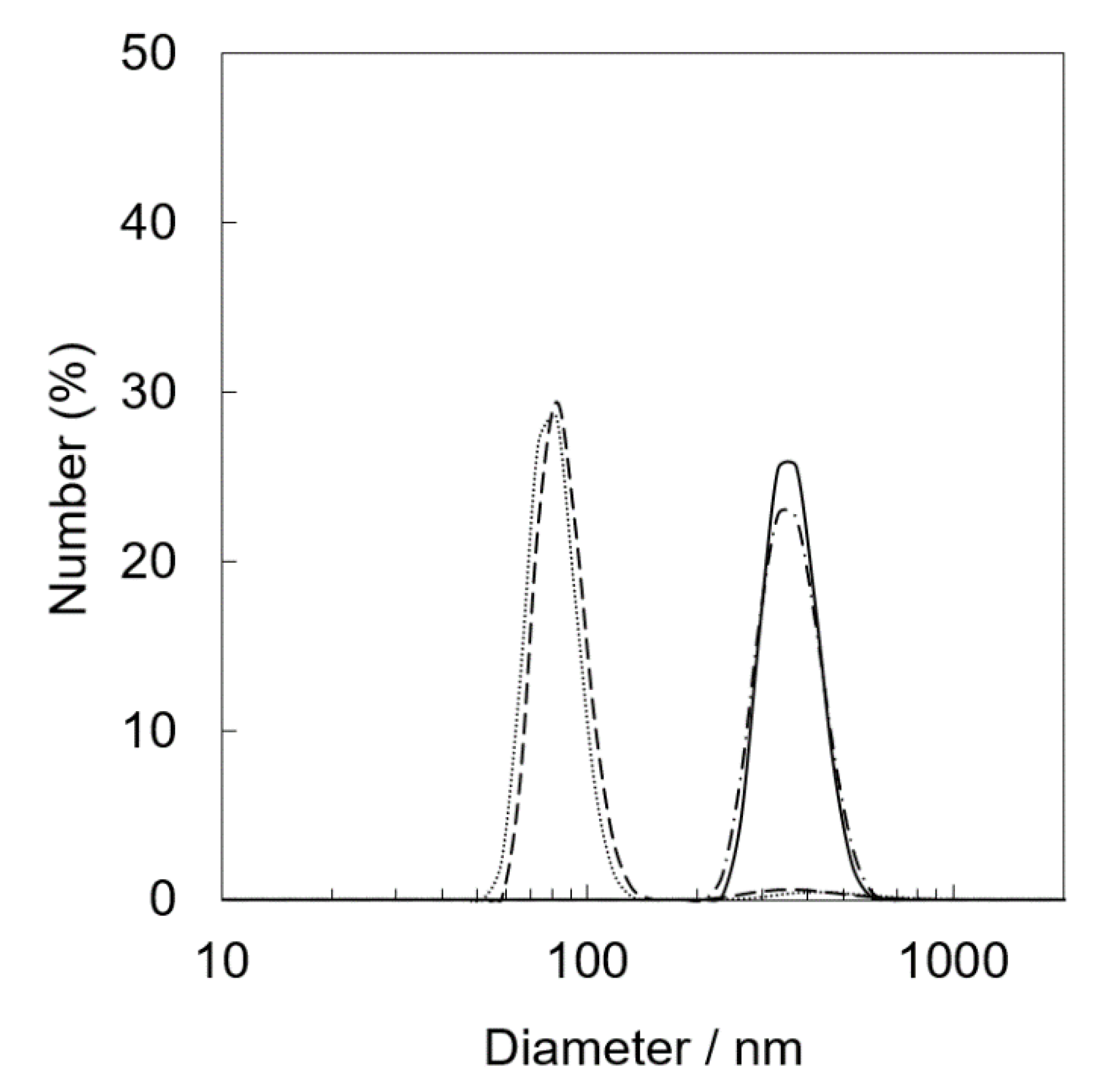

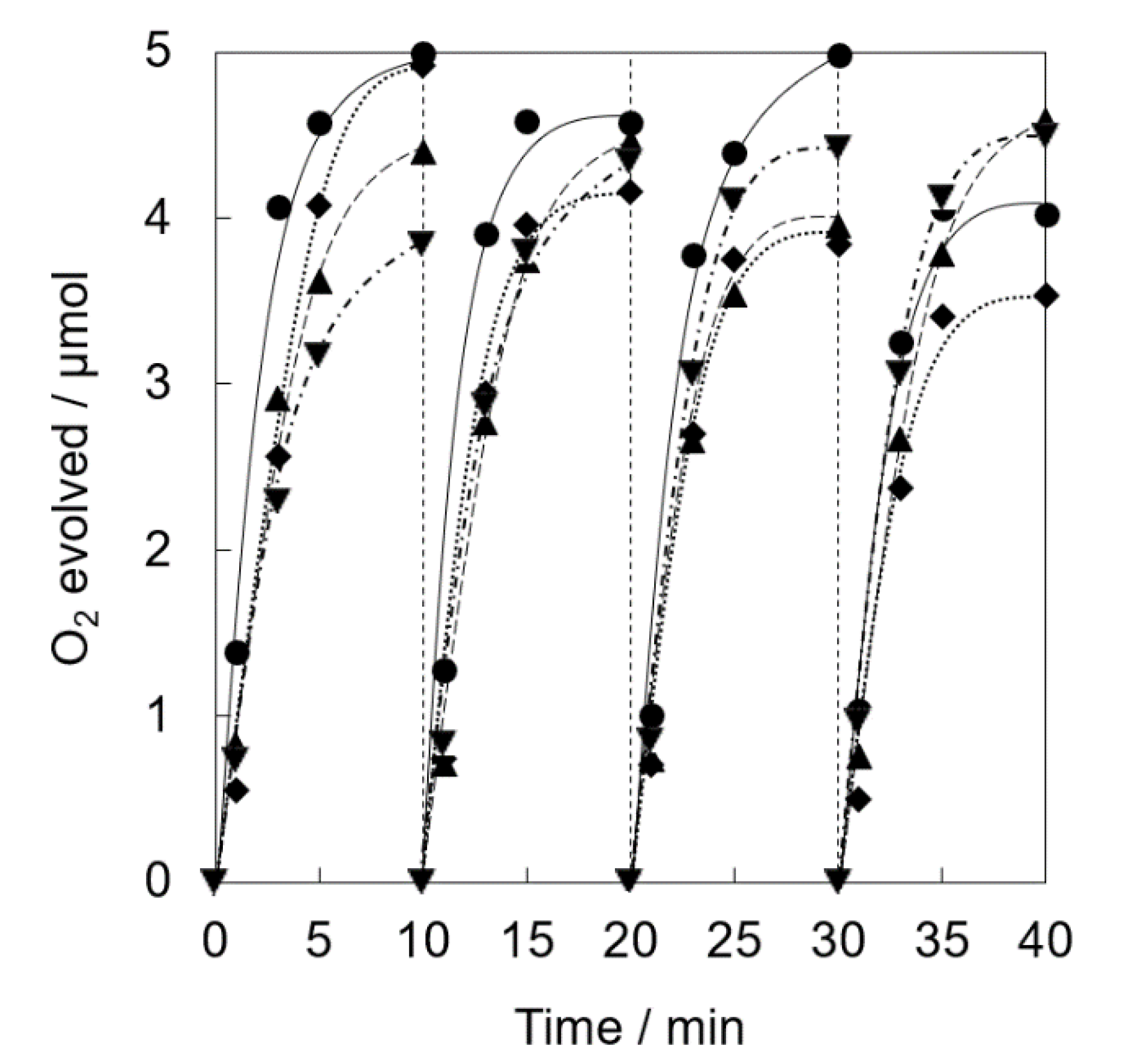
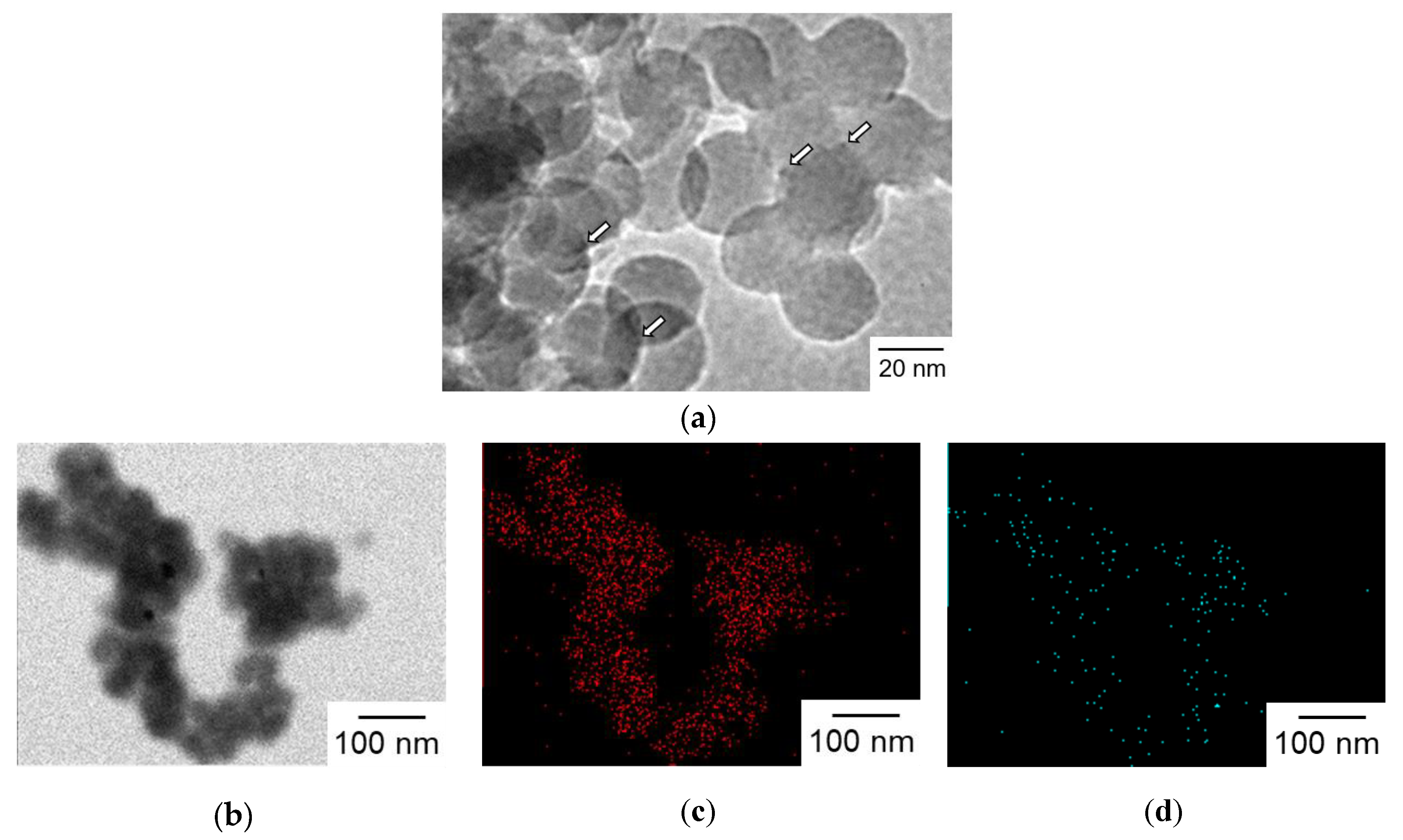
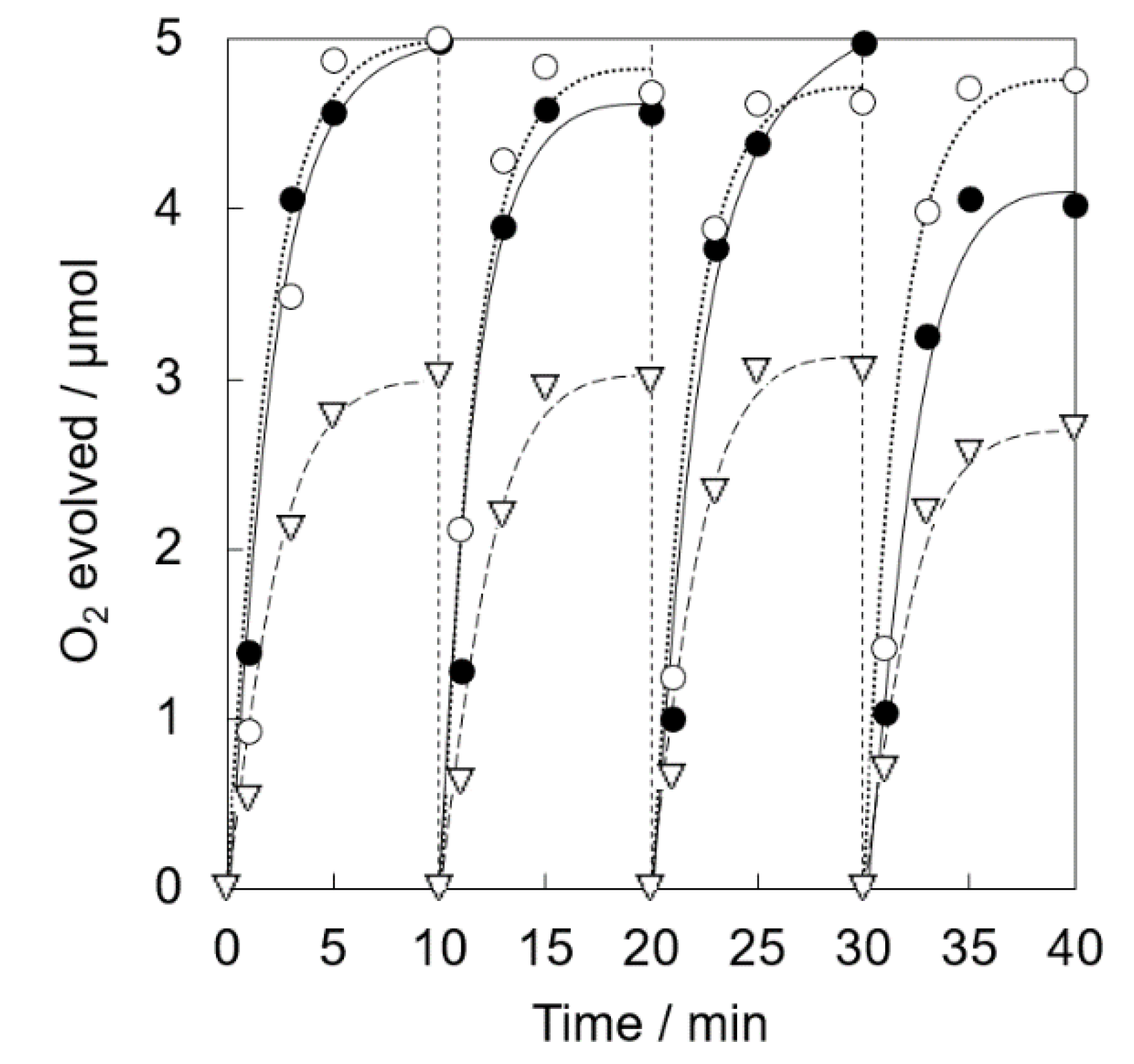
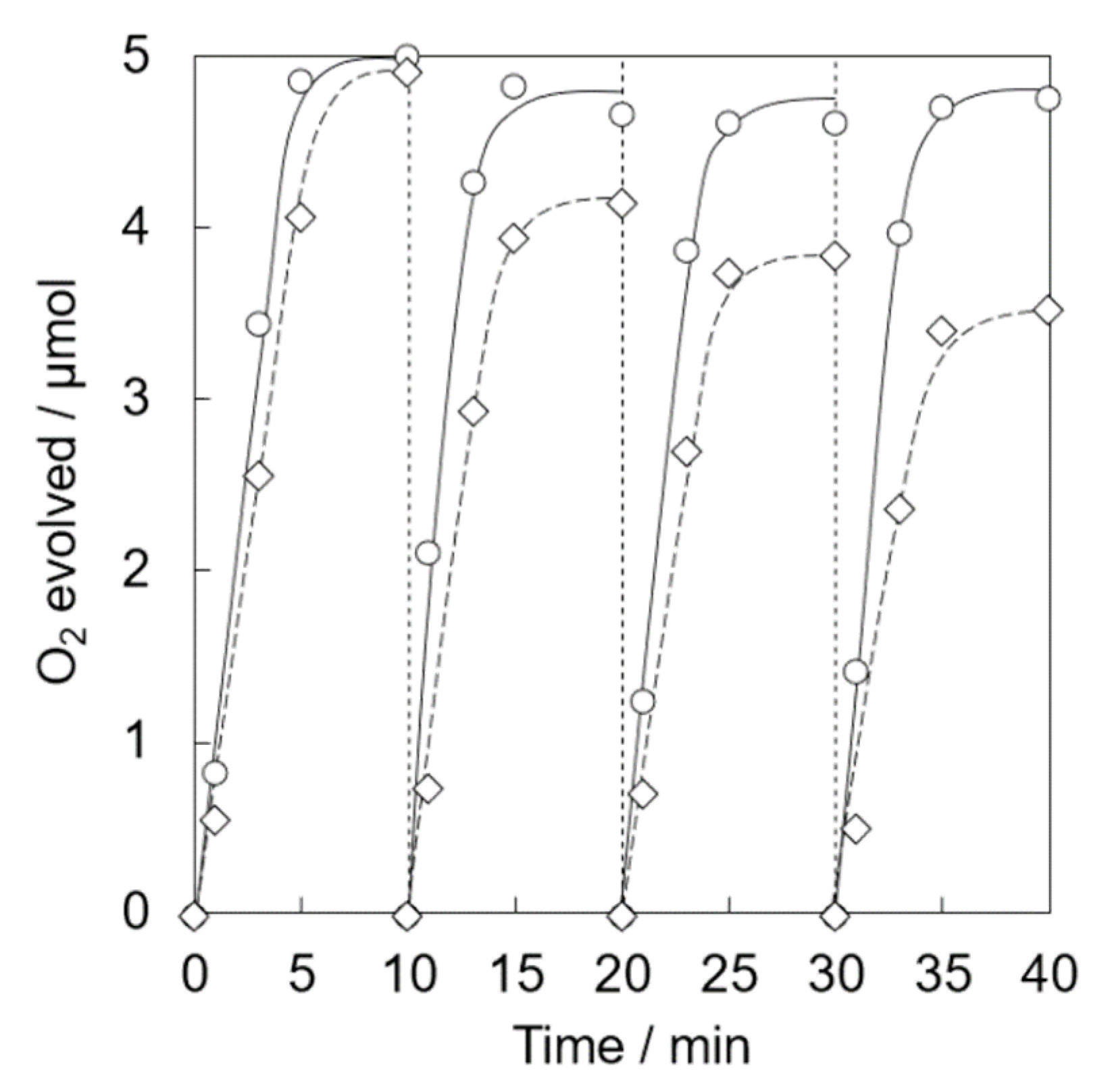

| Catalyst | [Ir]/[Si] | [Irafter]/[Irfresh] (%) | |
|---|---|---|---|
| Fresh | After the Reaction | ||
| Ir(OH)3/SiO2NPA(20)-CA | 0.072 | 0.019 | 26 |
| Ir(OH)3/SiO2NPA(20)-EA | 0.203 | 0.011 | 5.4 |
| Ir(OH)3/SiO2NPA(10)-CA | 0.087 | 0.032 | 37 |
| Ir(OH)3/SiO2NPA(50)-CA | 0.084 | 0.042 | 50 |
| Ir(OH)3/SiO2NPA(100)-CA | 0.109 | 0.032 | 31 |
| Ir(OH)3/Al-SiO2NPA(10)-CA ([Al] = 5 wt%) | 0.082 | 0.038 | 46 |
| Ir(OH)3/Al-SiO2NPA(20)-CA ([Al] = 1 wt%) | 0.097 | 0.035 | 36 |
| Ir(OH)3/Al-SiO2NPA(20)-CA ([Al] = 5 wt%) | 0.125 | 0.076 | 61 |
| Ir(OH)3/Al-SiO2NPA(20)-CA ([Al] = 10 wt%) | 0.077 | 0.041 | 53 |
| Ir(OH)3/Al2O3NPA-CA | 0.064 | 0.008 | 13 |
| Catalyst | S/m2 g−1 | R/nm | Sint/m2 g−1 |
|---|---|---|---|
| SiO2NPA(10) | 189 | 1.6 | 165 |
| SiO2NPA(20) | 109 | 2.4 | 108 |
| SiO2NPA(50) | 65 | 7.0 | 14 |
| SiO2NPA(100) | 38 | 14 | 5 |
| Ir(OH)3/SiO2NPA(20)-CA | 106 | 2.4 | 100 |
| Ir(OH)3/SiO2NPA(20)-EA | 101 | 2.4 | 85 |
| Ir(OH)3/SiO2NPA(10)-CA | 185 | 1.6 | 164 |
| Ir(OH)3/SiO2NPA(50)-CA | 69 | 7.0 | − |
| Ir(OH)3/SiO2NPA(100)-CA | 37 | 16 | 4 |
| Ir(OH)3/Al-SiO2NPA(20)-CA ([Al] = 1 wt%) | 110 | 2.4 | 106 |
| Ir(OH)3/Al-SiO2NPA(20)-CA ([Al] = 5 wt%) | 116 | 4.0 | 112 |
| Ir(OH)3/Al-SiO2NPA(20)-CA ([Al] = 10 wt%) | 95 | 7.0 | − |
| Al2O3NPA(20)-CA | 96 | 12 | − |
| Ir(OH)3/Al2O3NPA(20)-CA | 96 | 6.0 | − |
© 2020 by the authors. Licensee MDPI, Basel, Switzerland. This article is an open access article distributed under the terms and conditions of the Creative Commons Attribution (CC BY) license (http://creativecommons.org/licenses/by/4.0/).
Share and Cite
Sakamoto, G.; Tabe, H.; Yamada, Y. Immobilization of Ir(OH)3 Nanoparticles in Mesospaces of Al-SiO2 Nanoparticles Assembly to Enhance Stability for Photocatalytic Water Oxidation. Catalysts 2020, 10, 1015. https://doi.org/10.3390/catal10091015
Sakamoto G, Tabe H, Yamada Y. Immobilization of Ir(OH)3 Nanoparticles in Mesospaces of Al-SiO2 Nanoparticles Assembly to Enhance Stability for Photocatalytic Water Oxidation. Catalysts. 2020; 10(9):1015. https://doi.org/10.3390/catal10091015
Chicago/Turabian StyleSakamoto, Gentaro, Hiroyasu Tabe, and Yusuke Yamada. 2020. "Immobilization of Ir(OH)3 Nanoparticles in Mesospaces of Al-SiO2 Nanoparticles Assembly to Enhance Stability for Photocatalytic Water Oxidation" Catalysts 10, no. 9: 1015. https://doi.org/10.3390/catal10091015
APA StyleSakamoto, G., Tabe, H., & Yamada, Y. (2020). Immobilization of Ir(OH)3 Nanoparticles in Mesospaces of Al-SiO2 Nanoparticles Assembly to Enhance Stability for Photocatalytic Water Oxidation. Catalysts, 10(9), 1015. https://doi.org/10.3390/catal10091015




